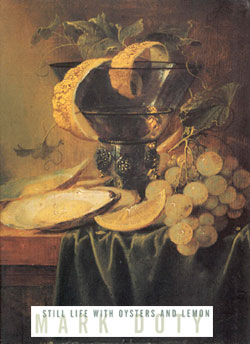 |
| Banquet Piece c. 1675 Abraham Hendricksz van Beyeren (Seattle Art Museum) |
Still in the afterglow of reading Mark Doty's Still Life With Oysters and Lemon, I visited the Seattle Art Museum (SAM) last week to enjoy the experience of standing in front of the museum's one still-life painting. Days beforehand, I imagined myself there at the museum, overwhelmed by light and color and richness and intimacy and meaning just like Doty was at the Metropolitan Museum of Art in New York. Did I forget somehow that I was not a prize-winning American poet--or any kind of poet at all?
I arrived at the museum knowing that the painting was European, but not knowing which floor or gallery held this painting. I wanted to wander the three floors of art and walk myself back in time from contemporary and post-Modern to the 17th century; I wanted to travel from Seattle to Africa to France to Italy and to Holland.
Ah, there it was, in a beautiful gilt frame. I stood before it looking looking looking.
It was a busy painting, a bit too busy for my taste, so it took quite a while to explore the canvas, to identify all the components, to begin to figure out how one thing related to another. I looked and stared and gazed. And I waited for something to happen. Niets. I was not having the Doty experience. I was disappointed. I paid $15 admission plus parking to have an experience. I had sent copies of Doty's book to a family and friends. I just stood there wishing someone would come in and clean up this mess of a feast. What a rube. What a fool. I knew better.
So I planted my feet and kept looking. I pulled out my camera, disabled the flash, and took many close-up photographs. I needed to look for myself to see what I saw not what Doty had prepared me to see.
Here, then, is the gold watch and pomegranate:
And here is the figure of the artist reflected in the curved shape of the silver pitcher:
And here is the lemon and its tendril of peel somehow "talking" with the folds of the burgundy and white table cloths to its right and the cluster of red grapes to its left:
And here is a goblet of white wine catching the light from the window:
And here is Beyeren's oysters and lemon (left)--for certain an acknowledgement of Jan Davidsz de Heem's Still Life with A Glass and Oysters of 1640 (right).
And then...I could hardly believe my eyes. There were the clouds! There! Look! Out the window behind the thick green drape:
Clouds never appear in still lifes! Neither do windows! There's always some invisible source of light illuminating the objects arranged on the tables. Look at this "classic" still life. See what I mean?
 |
| Still Life with Gilt Cup by Willem Claesz. |
The window is never in the painting. But here was a window showing actual clouds, not just a wash of blue sky or butterscotch-colored sunlight. Still Life with Clouds!
And then I starting seeing how the light from this window was reflected in all the shiny objects on the table. Look!
Now the painting was alive and my eyes were dancing all over its surface looking for the reflection of the window. And, strangely, it was an asymmetrical light--three panes of a four-paned, two-over-two window. And, even stranger, this could not be the reflection of the window with the green curtain and clouds. That reflection would take a different shape and would, based on the location of the window, be reflected on the backsides of the objects on the table. There was another window somewhere "off stage" being captured, curved, elongated, truncated, and bent by the artist in every vessel in the painting.
What does it all mean? Why did Beyeren include the window here? The curatorial notes next to this work offer no clues, but I can think of three reasons: 1) it balances the very dark space behind the arched doorway next to it, 2) it provides a visual "breath of fresh air" to a claustrophobic table setting--an escape of sorts for the viewer, 3) he wanted me to be happy.























